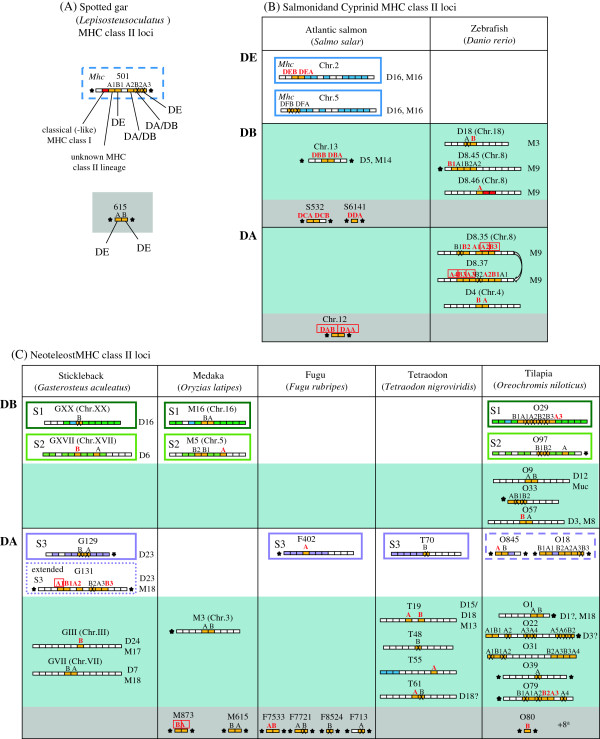Figure 2.

MHC class II loci in gar and various teleost fish. Schematic view of MHC class II A and B genomic regions as found for gar (A), salmon and zebrafish (B), and neoteleosts (C), and, for the teleost fishes, organized per DE, DB and DA group. Small blocks indicate genes, and stars indicate ends of scaffolds. Nomenclature and gene identities are explained in Additional file 2: Figure S2, and for salmon also in Additional file 8: Text S2. Synteny with class II genomic regions in other species is indicated by similar coloring of homologues: blue for Mhc-scaffold genes as found in human, dark green for neoteleost S1 region genes, lime green for neoteleost S2 region genes, and purple for neoteleost S3 region genes. Dotted and dashed purple lines indicate extended and probable S3 regions, respectively. Orange and red boxes represent MHC class II and MHC class I genes, respectively. “A” stands for a class II α chain gene and “B” for a β chain gene. Class II A and B gene names are in red font if matching transcripts were found (Additional file 5: Table S2 and Additional file 7: Text S1), and the name is boxed if matching transcripts were abundant. Crosses indicate pseudogenes and/or genes with incomplete information. White backgrounds indicate that in syntenic regions in other species also MHC class II genes were found, blue backgrounds indicate scaffolds without such class II synteny, and gray backgrounds indicate lack of sufficient sequence information for estimation of synteny. Observed synteny between teleost regions regardless of MHC class II presence (Additional file 4: Table S1) is summarized behind scaffolds by “M + number” and “D + number” for the respective chromosome numbers in medaka (M) and zebrafish (D for Danio), respectively. Linkage of classical-type class I and class II in spotted gar scaffold 501 suggests that this is an Mhc region, but more information on neighboring genes is needed (therefore dashed blue line). MHC class I genes on zebrafish Chr.8 are nonclassical [56]. The MHC class II genes and the Mhc-scaffold gene MSH5 (Additional file 2: Figure S2) in the neoteleost S1 group may or may not have derived from a direct translocation from the Mhc region on the same chromosome [33]. Tetraodon scaffold T55 has no synteny with regions in other species (Additional file 7: Table S1), so the linkage of T55 A gene with Mhc-scaffold genes (Additional file 2: Figure S2) is probably not ancestral. a Eight tilapia regions with little informative value were omitted from the figure, but are shown in Additional file 2: Figure S2.
